Intestinal lysozyme1 deficiency alters microbiota composition and impacts host metabolism through the emergence of NAD+-secreting ASTB Qing110 bacteria
- PMID: 38364095
- PMCID: PMC10949482
- DOI: 10.1128/msystems.01214-23
Intestinal lysozyme1 deficiency alters microbiota composition and impacts host metabolism through the emergence of NAD+-secreting ASTB Qing110 bacteria
Abstract
The intestine plays a pivotal role in nutrient absorption and host defense against pathogens, orchestrated in part by antimicrobial peptides secreted by Paneth cells. Among these peptides, lysozyme has multifaceted functions beyond its bactericidal activity. Here, we uncover the intricate relationship between intestinal lysozyme, the gut microbiota, and host metabolism. Lysozyme deficiency in mice led to altered body weight, energy expenditure, and substrate utilization, particularly on a high-fat diet. Interestingly, these metabolic benefits were linked to changes in the gut microbiota composition. Cohousing experiments revealed that the metabolic effects of lysozyme deficiency were microbiota-dependent. 16S rDNA sequencing highlighted differences in microbial communities, with ASTB_g (OTU60) highly enriched in lysozyme knockout mice. Subsequently, a novel bacterium, ASTB Qing110, corresponding to ASTB_g (OTU60), was isolated. Metabolomic analysis revealed that ASTB Qing110 secreted high levels of NAD+, potentially influencing host metabolism. This study sheds light on the complex interplay between intestinal lysozyme, the gut microbiota, and host metabolism, uncovering the potential role of ASTB Qing110 as a key player in modulating metabolic outcomes.
Importance: The impact of intestinal lumen lysozyme on intestinal health is complex, arising from its multifaceted interactions with the gut microbiota. Lysozyme can both mitigate and worsen certain health conditions, varying with different scenarios. This underscores the necessity of identifying the specific bacterial responses elicited by lysozyme and understanding their molecular foundations. Our research reveals that a deficiency in intestinal lysozyme1 may offer protection against diet-induced obesity by altering bacterial populations. We discovered a strain of bacterium, ASTB Qing110, which secretes NAD+ and is predominantly found in lyz1-deficient mice. Qing110 demonstrates positive effects in both C. elegans and mouse models of ataxia telangiectasia. This study sheds light on the intricate role of lysozyme in influencing intestinal health.
Keywords: Lyz1; NAD+; aging; gut microbiota; metabolism.
Conflict of interest statement
The authors declare no conflict of interest.
Figures
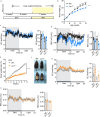
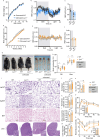
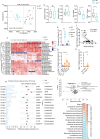
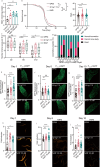
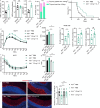
Similar articles
-
Intestinal α-Defensins Play a Minor Role in Modulating the Small Intestinal Microbiota Composition as Compared to Diet.Microbiol Spectr. 2023 Jun 15;11(3):e0056723. doi: 10.1128/spectrum.00567-23. Epub 2023 Apr 11. Microbiol Spectr. 2023. PMID: 37039638 Free PMC article.
-
High Fat Diet Alters Gut Microbiota and the Expression of Paneth Cell-Antimicrobial Peptides Preceding Changes of Circulating Inflammatory Cytokines.Mediators Inflamm. 2017;2017:9474896. doi: 10.1155/2017/9474896. Epub 2017 Feb 21. Mediators Inflamm. 2017. PMID: 28316379 Free PMC article.
-
Paneth Cell-Derived Lysozyme Defines the Composition of Mucolytic Microbiota and the Inflammatory Tone of the Intestine.Immunity. 2020 Aug 18;53(2):398-416.e8. doi: 10.1016/j.immuni.2020.07.010. Immunity. 2020. PMID: 32814028 Free PMC article.
-
[Intestinal microbiota and cardiometabolic risk: mechanisms and diet modulation].Arq Bras Endocrinol Metabol. 2014 Jun;58(4):317-27. doi: 10.1590/0004-2730000002940. Arq Bras Endocrinol Metabol. 2014. PMID: 24936725 Review. Portuguese.
-
NAD+ and its possible role in gut microbiota: Insights on the mechanisms by which gut microbes influence host metabolism.Anim Nutr. 2022 Jun 22;10:360-371. doi: 10.1016/j.aninu.2022.06.009. eCollection 2022 Sep. Anim Nutr. 2022. PMID: 35949199 Free PMC article. Review.
References
-
- Jang KK, Heaney T, London M, Ding Y, Putzel G, Yeung F, Ercelen D, Chen Y-H, Axelrad J, Gurunathan S, Zhou C, Podkowik M, Arguelles N, Srivastava A, Shopsin B, Torres VJ, Keestra-Gounder AM, Pironti A, Griffin ME, Hang HC, Cadwell K. 2023. Antimicrobial overproduction sustains intestinal inflammation by inhibiting Enterococcus colonization. Cell Host Microbe 31:1450–1468. doi:10.1016/j.chom.2023.08.002 - DOI - PMC - PubMed
MeSH terms
Substances
Grants and funding
LinkOut - more resources
Full Text Sources

